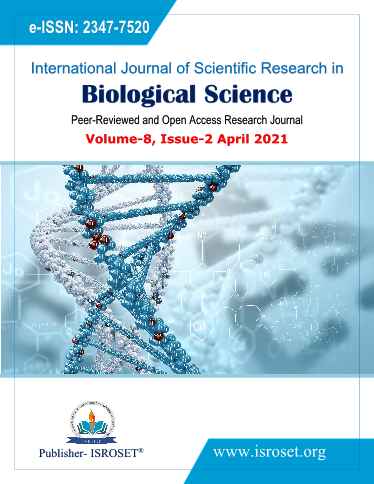Phytochemical Screening and Anti-fungal Activity of Annona senegalensis Pers Leaves and Stem Bark
Keywords:
Annona senegalensis, leaves, stem, phytochemicalAbstract
Annona senegalensis is an indigenous traditional medicinal plant found in Kebbi State, where dermatophytosis is becoming one of the major health challenge. The Annona senegalensis leaves and stem bark were obtained from Yauri L.G.A while, the fungal species namely; Microsporum cani, Epidermophyton flocossum, Trichophyton rubrum, Trichophyton mentographytes, Sporortrix schehenkii, Candida albican, Aspergillus flavus and Aspergillus niger were sourced from General Microbiology Laboratory, Federal University, Birnin Kebbi subjected to phytochemical screening and antifungal activities using standard methods at concentrations of 200, 300 and 400mg/ml. From the results obtained on phytochemical screening of Annona senegalensis leaves and stem bark extracts (aqueous and methanol) indicates presences of alkaloids, anthraquinones, flavanoids, saponins, cardiac glycosides, phenols, terpenoids, steroids, tannins and gum/mucilages which are antidermatophytic. Among all the fungal test organisms, Candida albicans showed significant zone of inhibitions (44.0%) and Trichophyton mentagrophytes with less inhibitions zone (24.0%) in leaves extracts. While in stem bark extracts visible growths inhibitions Aspergillus flavus had the highest visible inhibition of (33.0%), Trichophyton rubrum (28.0%), Aspergillus niger (30.0%), Candida albicans (27.0%), Microsporum cani (21.0%), Sporotrix schehenkii (21.0%) and Trichophyton mentagrophytes had the lowest (18.0%). In both extracts used Epidermophyton flocussum show resistance in which observed with (00.0%) percentage. The bioactive compounds presences in Annona senegalensis leaves and stem bark extracts (methanol) reveals its anti-fungal potentials against the test fungi when properly applied. These indicates the ability of the plant extracts to be used ethno-medicinally as viable antifungal in the treatment and management of dermatophytosis which may help to provide less cost and affordable treatment of dermatophytes infections in the study area and world at large.
References
V. Carla, C.P. Ana, S. Raquel, V. Susana, B. João, V. Cristina, Environmental Mycology in Public Health: Fungi and Mycotoxins Risk Assessment and Management. Academic Press, Science. Pp. 21–23, 2015.
M. Tim, K. Cameron, Common Skin Disorders. Elsevier Health Sciences, Medical. New York, NY: McGraw-Hill. Pp. 36-38, 2006.
K. Coates Palgrave, Trees of Southern Africa. Struik Publishers, Cape Town Ellis, D. H., Davis, S., Alexiou, H., Handke, R. and Bartley, R. (2007). Descriptions of Medical Fungi. 2nd Edition, Adelaide Medical Centre for Women & Children, Australia. Pp. 198, 2002.
J.N. Keta, A guide to the ethno-medicinal uses of some plants species in Kebbi State, North-western Nigeria. P. 64, 2016.
H. Mboh, Vegetation assessment of Taka Manda Forest Reserve. Thesis, Faculty of Agronomy and Agricultural Sciences, Univerrsity of Dschang. Pp. 123 – 126, 2001
R. Narasinga, Bioactive Phytochemical in Indian Foods and their Potential Health Promotion and Disease Prevention. Asia Pacific Journal of Clinical Nutrition, 12(1): 9-22, 2003.
I. Bakarnga-via, H.K. Yande, R.M. Kouipou, M.I.M. Kanko, J.M. Arc-en-ce, Effects of combined extracts from different plants parts of Annona senegalensis on antibacterial and antifungal activities. International Journal of Pharmacognosy and Phytochemical Research, 8: 162-166, 2016.
O. Anthony, O. Said, I. Hamis, M. Ame, O. Odalo, Assessment of antifungal activity of Annona senegalensis plant parts on Malassezia globosa. National Product of Chemical Resources, 5:291, 2017.
A. Tukur , Musa M.N, H.A Bello, N.A. Sani Determination of the Phytochemical Constituents and Antifungal Properties of Annona senegalensis Leaves (African Custard Apple). Chem Search Journal, 11(1): 16 – 24, 2020
S. Gupta, K. Kulshreshth, A. Datta, Bio-Control of Clinical Fungal Isolates associated with fungal keratitis using medicinal plant extracts. International Journal of Pharmacological Science, 4(4): 544–547, 2012.
G.N. Agrios, Plant Pathology. 5th Edition, Elsevier Academic Press, Amsterdam, New York, USA. P. 922, 2005.
D.H. Ellis, S. Davis, H. Alexiou, R. Handke, Bartley, Descriptions of Medical Fungi 2nd Edition, Adelaide Medical Centre for Women & Children, Australia. P. 198, 2007.
G.T. Trease, W.C. Evans, Pharmacognosy. 5th Edition, Elsevier, New Delhi, India, P. 585.
Association of Analytical Chemists, Official methods of Analysis. Washington, D.C, USA. P. 450, 2000.
S.O. Ogbonnia, N.V. Enwuru, E.U. Onyemenen, G.A. Oyedle, Phytochemical evaluation and antibacterial profile of Treculi Africana Decne bark ex-tract on gastrointestinal bacterial pathogens. Afr J Biotechnol, 7: 1385-1389. 44, 2008
L. Ostrosky-Zeichner, A. Casadevall, J.N. Galgiani, F.C. Odds, J.N. Rex, An insight into the antifungal pipeline: selected new molecules and beyond. www.nature.com/reviews/drugdisc, 2010.
M. Freile, M. Giannini, M. Sortino, M. Zamora, A. Juarez, S. Zacchino, D. Enriz, Antifungal activity of aqueous extracts and of Berberine Isolated from Berberis heterophylla. Journal of Biological Science, 25: 83–88, 2006.
V. Kuete, J. Kamga, P.L. Sanjo, B. Ngameni, H.M. Poumale, P. Ambassa, B.T. Ngadjul, Antimicrobial activities of the methanol extracts, fractions and compound from Ficus polita Vahl. (Moraceae). International journal of Complementary and Alternative Medicine. 11: 6, 2011
Downloads
Published
How to Cite
Issue
Section
License

This work is licensed under a Creative Commons Attribution 4.0 International License.
Authors contributing to this journal agree to publish their articles under the Creative Commons Attribution 4.0 International License, allowing third parties to share their work (copy, distribute, transmit) and to adapt it, under the condition that the authors are given credit and that in the event of reuse or distribution, the terms of this license are made clear.







